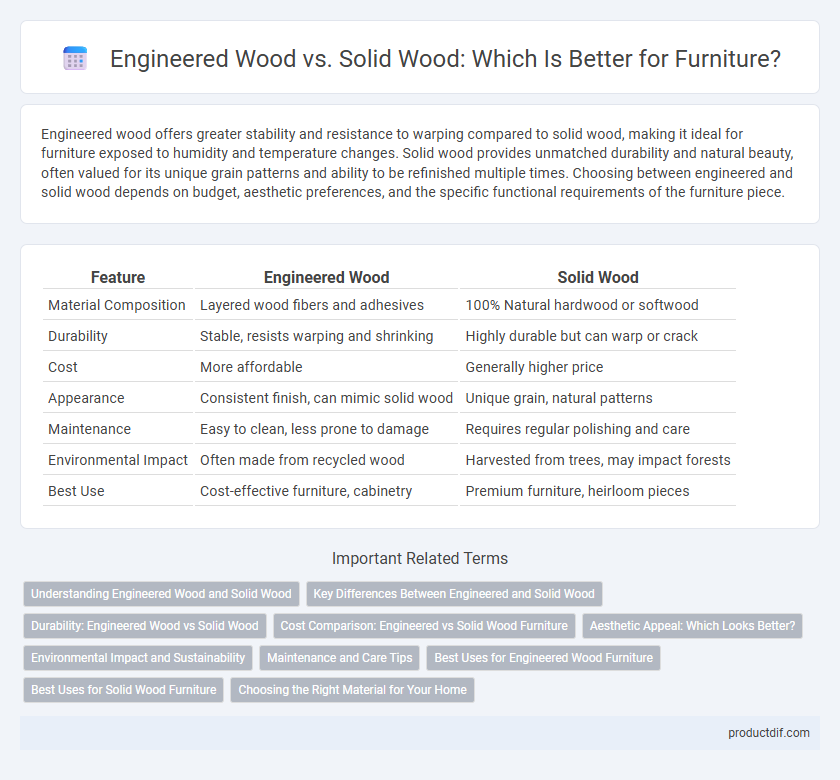Engineered wood offers greater stability and resistance to warping compared to solid wood, making it ideal for furniture exposed to humidity and temperature changes. Solid wood provides unmatched durability and natural beauty, often valued for its unique grain patterns and ability to be refinished multiple times. Choosing between engineered and solid wood depends on budget, aesthetic preferences, and the specific functional requirements of the furniture piece.
Table of Comparison
| Feature | Engineered Wood | Solid Wood |
|---|---|---|
| Material Composition | Layered wood fibers and adhesives | 100% Natural hardwood or softwood |
| Durability | Stable, resists warping and shrinking | Highly durable but can warp or crack |
| Cost | More affordable | Generally higher price |
| Appearance | Consistent finish, can mimic solid wood | Unique grain, natural patterns |
| Maintenance | Easy to clean, less prone to damage | Requires regular polishing and care |
| Environmental Impact | Often made from recycled wood | Harvested from trees, may impact forests |
| Best Use | Cost-effective furniture, cabinetry | Premium furniture, heirloom pieces |
Understanding Engineered Wood and Solid Wood
Engineered wood consists of multiple layers of wood veneers or fibers bonded with adhesives, offering enhanced stability and resistance to warping compared to solid wood, which is made from a single piece of timber. Solid wood provides natural grain patterns, durability, and the ability to be refinished over time, making it ideal for long-lasting furniture pieces. Engineered wood's cost-effectiveness and resistance to moisture make it a popular choice for modern furniture manufacturing without sacrificing aesthetic appeal.
Key Differences Between Engineered and Solid Wood
Engineered wood consists of multiple layers of wood veneers or fibers bonded with adhesives, offering enhanced stability and resistance to warping compared to solid wood, which is a single piece of natural timber. Solid wood provides unique grain patterns and greater durability but is more susceptible to environmental changes like moisture and temperature. Engineered wood is often more cost-effective and environmentally friendly due to efficient use of raw materials, while solid wood is valued for its traditional aesthetic and long-term strength.
Durability: Engineered Wood vs Solid Wood
Engineered wood offers improved resistance to warping, cracking, and moisture damage due to its layered construction, making it a durable option in variable climates. Solid wood provides natural strength and longevity, with the ability to be refinished multiple times, extending its lifespan significantly. While solid wood can be more susceptible to environmental changes, engineered wood's stability makes it a reliable choice for furniture durability.
Cost Comparison: Engineered vs Solid Wood Furniture
Engineered wood furniture typically costs 25-40% less than solid wood due to lower raw material expenses and more efficient manufacturing processes. While solid wood furniture offers longer durability and higher resale value, engineered wood provides affordable options with decent strength and appearance. Budget-conscious buyers often prefer engineered wood for cost-effective designs without sacrificing style.
Aesthetic Appeal: Which Looks Better?
Engineered wood offers a consistent grain pattern and uniform finish that enhances modern furniture aesthetics, while solid wood boasts unique natural grains and rich textures that bring warmth and character to any space. The choice between engineered and solid wood depends on design preferences, with engineered wood excelling in sleek, contemporary styles and solid wood preferred for rustic or traditional looks. Both materials provide visually appealing options, but solid wood's natural variations often make it the preferred choice for those seeking authentic beauty.
Environmental Impact and Sustainability
Engineered wood products, such as plywood and MDF, utilize smaller wood fibers and adhesives, resulting in more efficient use of forest resources and less deforestation compared to solid wood harvesting. Solid wood furniture, harvested from whole trees, generally has a longer lifespan and can be sustainably sourced through certified forestry practices like FSC certification, promoting responsible forest management. Overall, engineered wood reduces waste and promotes recycling, while solid wood offers durability and potential carbon sequestration benefits, both playing important roles in sustainable furniture production.
Maintenance and Care Tips
Engineered wood requires less maintenance than solid wood, as its layered structure resists warping and moisture damage, making it ideal for humid environments. Regular dusting and occasional damp cloth wiping prevent surface buildup, while avoiding excessive water exposure preserves its integrity. Solid wood demands more intensive care, including periodic polishing and the use of protective finishes to prevent scratches, dents, and moisture penetration.
Best Uses for Engineered Wood Furniture
Engineered wood is ideal for furniture pieces requiring high stability and resistance to warping, such as cabinets, shelving, and flat-pack furniture. Its layered construction makes it perfect for modern designs and budget-friendly options without sacrificing durability. Engineered wood performs well in environments with fluctuating humidity, making it suitable for kitchens, bathrooms, and basements.
Best Uses for Solid Wood Furniture
Solid wood furniture is ideal for heirloom-quality pieces such as dining tables, bed frames, and cabinets where durability and natural beauty are paramount. Its dense grain and strength make it suitable for high-traffic areas and weight-bearing applications, ensuring longevity and timeless appeal. Solid wood also allows for refinishing and customization, enhancing its value over engineered wood in luxury and traditional furniture designs.
Choosing the Right Material for Your Home
Engineered wood offers enhanced stability and resistance to moisture, making it ideal for areas with fluctuating humidity or temperature changes. Solid wood provides unmatched durability and natural beauty, adding timeless value to your home's interior with its unique grain patterns. Consider the specific room environment, budget, and desired longevity when choosing between engineered wood and solid wood for furniture.
Engineered wood vs Solid wood Infographic

 productdif.com
productdif.com